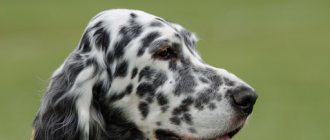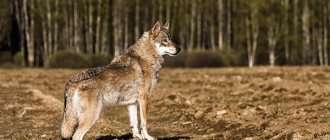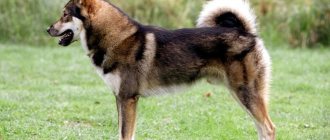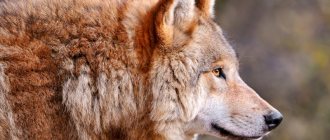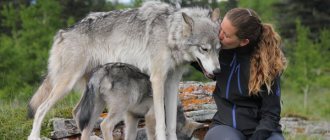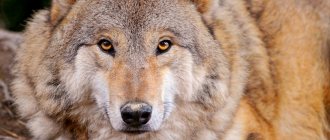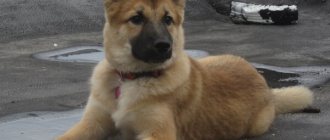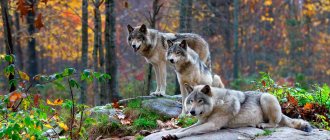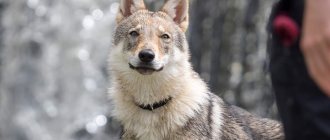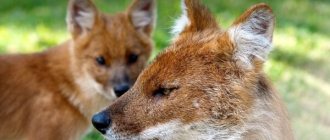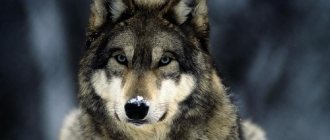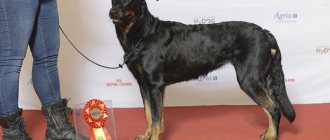- October 27, 2018
- Hunting
- Barinova Vera
Two related species of animals, so different from each other, can confuse an inexperienced tracker. Even those who encounter these animals every day do not know how wolf tracks and dog tracks differ from each other in the snow. Only observation and careful attention to detail allow the hunter to identify significant differences. Meanwhile, there are quite a lot of them. What do you need to know about footprints in general, and wolf prints in particular? What do changes in the nature of tracks indicate? How are the structural features of a wolf or dog reflected in their prints in the snow?
General information about wolves
The wolf is an incredibly powerful animal, with a gray coloration and a dark saddle-shaped spot on its back. Its head is large, and its body length often exceeds 100–130 cm. The largest representatives of the species are found in Central Russia, in the North, where the weight of the animal reaches 80 kg, and in other cases it ranges from 35 to 60 kg. Desert wolves are much smaller than northern wolves.
This predator searches for food in open areas and is found in river valleys and in quiet places near the shore. The most common prey a wild animal gets is carrion, ungulates, birds and rodents. This is why wolf tracks can often be found near pastures.
Wolves are widespread in Russia, although they will not come closer than 60–80 km to a big city. They are nocturnal animals, living in a pack of 6 to 10 family members. The latter are classified as follows:
- Profits - less than a year, approximately 5-7 heads.
- Pereyarki - from one year old, last year's brood. By July they begin to howl in hunting areas and dens.
- Seasoned - more than two years. From April to October they live sedentary, raising broods.
- Old - more than five years old, with broken teeth and unable to hunt.
Wandering from place to place, predators leave many prints in the snow that look like those of a dog.
Human interaction
For humans, dogs today are real pets, protectors and helpers. They are distinguished by friendliness, obedience and a number of other individual qualities that distinguish different individuals and representatives of different breeds from each other. They cannot stand prolonged loneliness and are very bored when their owners are away from home for a long time.
But this cannot be said about their wild relatives, who love solitude and do not need constant communication. In addition, they are characterized by increased aggressiveness. For example, the latter, in severe hunger, can attack an animal or person without hesitation, while domestic animals are in no hurry to get involved in a fight with a predator, with the exception of protecting themselves or their owner.
At the same time, research confirms that dogs are able to understand humans much better than their predatory counterparts. To prove this, scientists conducted an experiment: they placed 2 closed containers with meat in front of wolf cubs and puppies and told them with facial expressions and gestures where exactly the treat was hidden. As a result, the puppies, compared to wolf cubs, understood clues and found food faster.
For wolves, which are accustomed to wild habitats, rapport with humans is not an important skill. At the genetic level, they perceive each other as a source of danger, since their meetings in most cases do not bode well for either one or the other. For example, in the forest a person usually acts as a hunter who needs a trophy, not new friends.
Amazing video about the friendship between a man and a she-wolf:
The wolf (canis lupus), also called the gray wolf or common wolf, is a predatory mammal belonging to the canidae family. The wolf belongs to the wolf genus, which also includes the coyote and jackal. In the canine family, the wolf is the largest animal.
Here are its dimensions: the length of the wolf is up to 150 cm, including the tail - 2 m, height at the withers - 90 cm, body weight - the same as the weight of an adult, maybe up to 90 kg.
According to recent studies of wolf DNA, it has been established that the wolf is the ancestor of the dog. Probably a long time ago, wolves were domesticated and a breed of domestic wolf - a dog - was developed.
The wolf was previously distributed quite widely throughout the world, especially in Eurasia and America. Currently, as a result of the mass extermination of the wolf, and due to the spread of cities and villages, the wolf's habitat has sharply decreased.
Moreover, in some regions this predator is now not found at all. In other regions it appears less and less often, because there are areas in which hunting it is still not prohibited. It continues to be exterminated, since this predator still kills livestock, can attack humans, and besides, hunting a wolf is an old human pastime.
However, the wolf brings great benefits - it regulates the balance of the ecosystem, for example, in the taiga, in the steppes and mountains, in the tundra, the wolf helps nature get rid of dying or sick animals, thereby healing the gene pool of nature.
There are 32 subspecies of wolves in the world. In Russia you can find common and tundra wolves.
Features of the view
Despite the fact that the wolf is a cautious animal, its favorite places are almost the entire landscape, where open territory predominates. Traces of a wolf can be found in the steppe, forest-steppe, deserts, and sparse forests. The life of a male takes place next to a she-wolf, who is his permanent mate. Near their lair there are always many wolf prints, and the smell of the decaying remains of victims is mixed with the spirit of the owners of the home themselves.
A she-wolf's pregnancy lasts about 65 days, after which traces of wolf cubs appear near the den. Despite the created family, it is difficult to even catch a glimpse of a pair of wolves - they notice danger long before it appears on the horizon, and manage to hide or move to another place. Therefore, a hunter can, for a long time, without seeing a live wolf, encounter its tracks in the snow, wet ground, or sand. Let's look at how dog and wolf prints differ in size, character and location on the ground.
She-wolf care
Wolves are distinguished by their intelligence, ability to learn, and variety of emotions. In fact, predators are very similar to people in this regard. In particular, the she-wolf is the embodiment of an ideal mother who carefully prepares for motherhood.
She-wolf with cubs
Stages of motherhood in she-wolves
At the initial stage of pregnancy, the she-wolf spends a lot of time with the male, since in the future she will be completely occupied with the offspring. Then the female looks for a suitable place for a den and arranges it. At first, other members of the pack are prohibited from entering, but when the wolf cubs grow up, the whole family will take care of the offspring.
Wolf's hole
The birth of wolf cubs occurs in the den. The female has innate abilities and knowledge regarding how to behave during childbirth and with offspring. She regularly licks and feeds the babies, never leaving them alone.
Important characteristics of the she-wolf
The maternal instinct of a she-wolf is innate. She takes care of the kids in every possible way. In general, for every female, the birth of offspring is the main goal. The she-wolf is completely selfless when it comes to her puppies. She may go hungry and thirsty for days, but she will not leave her cubs in danger.
Wolf cubs at the lair
Large stray dogs
It is with them that wolves can most often be confused - approximately the same body constitution, life in packs and in characteristic habitats makes domestic animals similar to their wild brothers. But stray dogs are much smaller than a wolf, which is why wolf tracks can be recognized by their size: if the paw is large, then it is unlikely to be a dog.
It is also worth paying attention to the area where paw prints were found; for example, in a dense forest they will belong to a seasoned animal. And in the reeds near the shore or field - a dog, which, as a rule, does not run away from the house more than 10 km.
Let's look at the difference between the tracks of a wolf and a dog, in the photo
Wild animals do not spread their fingers like their counterparts, so their tracks always look more collected or “slender.” Thus, the paw print of a large dog and a small wolf in the snow will still be different: a small but collected footprint will not allow it to be confused with a large and wide wolf print. The pet initially holds its paw as if in a fist and gently advances. By lowering its paw onto its toes, the dog does not spread them out, since it does not need to increase the area of support.
We will further understand the difference between a dog's track and a wolf's. If you number the wolf claws from 1 to 4, you can see that they are located in pairs: the first and fourth are on the same level and you can draw a straight line from their claws. And the second and third are set slightly forward, while their beginning will lie on the line of the claws of the first pair. Between the second, you can also mentally draw a straight line parallel to the first. This will not work for a dog - all its fingers are located in a semicircle and at the same distance from each other.
Maintenance and care
Karelo-Finnish huskies can live in an enclosure, but, unlike their West Siberian relatives, they are very attached to people.
It is advisable to take them into the house. Karelians do not mind frosts; they have a thick undercoat and guard hairs are well developed, although they do not seem too fluffy. It is necessary to eliminate all sources of drafts in an apartment or house. In the heat they feel satisfactory. Daily walking is required. Puppies are taken out more often, and adults less often, but their time spent in the fresh air is increased.
It is important to socialize your dog from an early age. After quarantine due to vaccinations, many Karelian owners find company on a walk so that the puppy develops and learns how to behave in society
Feeding Karelians is standard. The diet consists of the following products:
- Raw meat (most of the serving);
- Cottage cheese, kefir;
- Kaltyks and offal;
- Raw large bones.
The Karelian coat is wild type and therefore does not require care. They shed twice a year according to the season. They have no noticeable odor. During molting, comb with regular combs and slicker brushes several times a week. After it, it is enough to take up combs once a week. Wash when dirty or a couple of times a year. Karelian-Finnish huskies are not cut and their fur is not plucked.
We suggest you familiarize yourself with Acanthosis nigricans in dachshunds treatment
Print distance
The impression of dog and wolf tracks is also influenced by the manner of walking and the pads of the fingers. In a domestic animal, they are less convex, which is why the wolf's paws leave more prominent prints in the snow. A wild animal transfers the weight of its body to its front paws, which is why they leave a deeper and larger footprint than their hind paws. The dog carries its body weight relatively evenly, and therefore there is no such difference between the front and hind limbs. Due to the size of the tracks, you can notice other features that are not visible at first glance: gender, age, special features.
Thus, an experienced hunter who knows the inhabitants of a given area and understands tracks can track a particular wolf for a long time by the way it places its paws, what scars it has on its fingertips, claws and favorite places. Two wolves cannot have absolutely identical limb prints, just like people’s palms. However, differences will be observed in other aspects as well.
Conclusions website
- The dog is a subspecies of the wolf species, to which wolves belong;
- The dog is domesticated by man, and the wolf is a wild animal;
- Dogs differ from wolves in their body structure and use of vocal signals;
- We can talk about the social behavior of dogs, which is specific to each individual and each breed. Wolves have no social behavior other than nature-based behavioral patterns.
As Konrad Lorenz correctly noted: “There is no other animal that would so radically change its entire way of life, its entire sphere of interests, and would become so domesticated as a dog.” That's right, it was domestication that became the basis for the fundamental differences that we see today between the wolf and the dog. But once upon a time there were no such differences at all. Both the wolf and the dog are mammals of the canine family, the species wolf. Moreover, the dog is a subspecies of this species. One of the first differences that comes to mind is that wolves live in the wild and in zoos, while dogs live among people. This is perhaps true, with the exception of wild dogs, which, however, can almost always be successfully classified as “hyenas”, “jackals” and the like. Due to living side by side with humans for a very long time - a natural factor, as well as tireless selection carried out by people - an artificial factor, dogs have changed. Despite the fact that today some breeds of dogs look significantly similar to a wolf (for example, huskies), most of our four-legged friends are similar to their ancestor, but distantly. Wolves are large representatives of their family. Dogs differ quite seriously in this parameter: the smallest dog in the world is much smaller than the smallest wolf, and the largest dog in the world is also much larger than the largest wolf in the world. Dog paws are not as large as those of wild wolves. A dog's tail, as we know, can be raised up, which will signal the dog's high spirits. A wolf's tail is always down. Until now, the wolf has ears that are pointed, triangular in shape, and erect - which cannot be said about dogs, which can boast of the most varied shapes and positions of the auricle. This also applies to the tail - the wolf’s tail is moderately fluffy, quite large, and some dogs have a curled tail. Physiologically, dogs are fully formed, that is, they complete puberty by seven to eight months, and wolves do this after living for a couple of years. Dogs and wolves know how to interact with their environment in the same way: by howling and barking. But dogs howl less often and bark more often. The remaining differences relate to the social aspect that dogs have developed over many generations. Without communicating with humans, wolves do not reveal these qualities in themselves. Sometimes both of them attack a person, while a hungry wolf can attack a dog; a dog will attack a wolf only for the purpose of self-defense as an emergency measure. Wolves are active at night; this can hardly be said about dogs, they have adapted so well to our way of life, and besides, they do not tolerate loneliness well. Due to their close proximity to humans, dogs have been much better studied than wolves. Each of us can observe the behavior of such a familiar animal - a dog. And anyone will note such a trait of dogs as individuality (that is, a set of specific characteristics), which cannot be said about wolves. At the same time, many dogs are distinguished from wolves by such qualities as tolerance, friendliness, endurance and obedience.
The tracks will tell you a lot
You can find out whether a male or a female has recently walked through the snow by their size: if the length of the first track is 1.3 times greater than the width, then the female’s is 1.5 times greater. The she-wolf has smaller footprints, which are also slightly longer compared to the prints of a male of the same age. In addition, urine on the snow gives a clue about gender: while a wolf tends to urinate on vertical objects, the she-wolf leaves a neat horizontal puddle.
Wolf tracks will also tell you a lot about the age of the animal:
- Profits - 8.5 cm in length.
- Pereyarki - 9.3 cm in length.
- Old ones - 10.5 cm in length.
There are tracks 14 cm in length, but these are average figures for a Central Russian wolf. Naturally, females have tracks slightly smaller than males and the numbers then decrease by several mm. Saint Bernards, Great Danes and Caucasian Shepherds leave tracks larger than 12 cm, however, if this is not their territory for walking, then the tracks are unlikely to belong to dogs.
physical characteristics
Dogs have relatively smaller skulls with different snouts, physically smaller brains, smaller teeth, and different leg lengths compared to wolves. Smaller brains require fewer calories for dogs to survive. A dog's paw is half the size of a wolf's paw, and some dogs' tail curves upward, unlike a wolf's. Dog teeth have a less complex pattern of sharp ridges and a much smaller tympanic cavity compared to wolves.
Wolves have larger, wider skulls with longer snouts, physically larger brains, and larger teeth and legs. They have a narrow chest with their front legs pressed against it. Elbows point inward and feet point outward. Additionally, wolves have a precaudal gland at the base of their tail, used to release a pheromone onto another wolf, marking that wolf as a member of a particular pack. This gland is vestigial in dogs and functions only minimally in dogs.
What else is the difference between the tracks of a wolf and a dog?
It is interesting that the nature of the tracks depends on what gait a representative of one of the species was moving at the moment. For example, a step is a slow chain that can stretch over long distances. With this gait, a wolf goes to rest after a successful hunt and a hearty dinner. The length of the steps is usually about 25 cm, and the chain is less even than if he were trotting or trotting.
A dog is another matter: it can also walk for quite a long time over long distances, but the trajectory is rarely smooth, and the chain of tracks turns out to be winding. In addition, the dog moves faster from walking to running and vice versa.
The wolf moves most often at a trot, and therefore such tracks are the most common. In this case, the hind paws fall exactly into the front paws, forming a chain of uniform tracks of the front paws. The hind limb may not exactly match the imprint of the front one, then it is duplicated and it becomes finally clear that the wolf was moving at a trot. This is a way to hide from danger, and thus a wild animal can travel 70 km in a night.
Animal differences
First of all, it is worth noting the obvious difference: the wolf is a wild animal, and the dog is domesticated by man, which is distinguished by the diversity of species and significant differences in appearance, which sometimes make them completely different from representatives of the same canine family. But even those breeds that really look like their wild relatives have a number of characteristic features, knowing which you can easily distinguish one animal from another.
The differences between a wolf and a dog are manifested in the following parameters:
- Head shape and muzzle. The wolf's head is shaped like the head of the German Shepherd breed, but it is more massive and has a more elongated and pointed muzzle.
- Ears. Wolves are simply not able to press them to their heads, so they always keep them raised. The ears are usually small in size relative to other parts of the body and are overgrown with hair on both the outer and inner surfaces.
- Tail. In wild predators, the tail never curls, is held horizontally to the ground or lowered down and always remains practically motionless. Only pets are characterized by wagging their tail to express emotions.
- Jaws. Representatives of wolves have a fairly narrow jaw, which is characterized by greater strength.
- Eating. Wild predators always eat very slowly because they may choke.
On a note! The characteristic groans and whines during a meal are associated precisely with the rapid swallowing of food, as a result of which wolves experience pain.
- Movement style. The wild predator moves at a trot, and its hind legs are placed exactly in the already imprinted tracks of the forelimbs. When moving in groups, they follow each other in the tracks of the first animal in the pack, which makes it easier to move long distances.
- Movement speed. Although predators can stalk prey for days, they cannot sustain high-speed pursuit over long distances (more than 300 m).
- Attitude towards prey. During a hunt or fight, a dog immediately bites the victim to death, while a wolf seems to cut it into pieces, which is due to the anatomical features of the structure of the jaws.
Location of traces
Let's look at the photo, at the trail of a wolf running through the quarry. It can be easily distinguished from other gaits: the hind legs are lifted slightly ahead of the front ones, which is why the hind and front legs stand in pairs, forming a gap between them. This is most typical for dogs, and therefore it is difficult to distinguish a domestic animal from a wild animal using such tracks. The trail can be determined after the individual moves to a slower pace - wolves catch nearby prey, thus this chain will change to another, more characteristic one.
Animal physiology also influences the difference between tracks. In dogs, there is approximately the same distance between the two front and hind limbs, while there is a more visible gap between the front and rear pairs. That is, the dog never runs in a straight path, it meanders. Because her limbs are located on the sides of the chest. In a wolf, all four paw prints are evenly spaced from each other because its limbs are located exactly under the ribcage, regardless of its width. Therefore, his prints, like those of a fox, are on the same line, while those of a domestic animal are to the left and right of the line.
Let's look into the issue further
The tracks of a wolf can change their character if it is a pack. It is interesting that wild animals walking behind try to follow those in front. Because of this, it becomes difficult to figure out whether one wolf or the whole pack was moving here. This method of movement makes it easier to cover distances along a deep trail and has the additional advantage of confusing enemies. But there are several differences:
- The protruding lower one is clearly visible from the top print.
- The tracks are deeper.
- There may be places where the prints move away and then come back together: tired wolves change places.
For dogs, this behavior is unnatural and the described tracks can definitely be considered wolf marks. A string of prints, their straightness, depth, distance between the paws can tell a lot about the animal, and therefore the tracker skill is very useful for the hunter.
